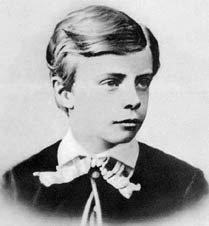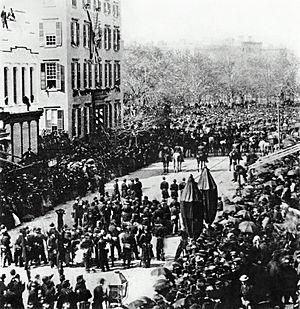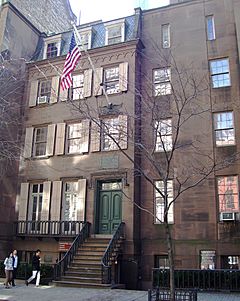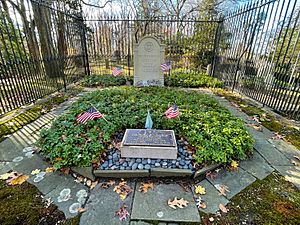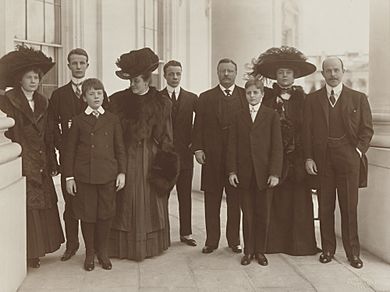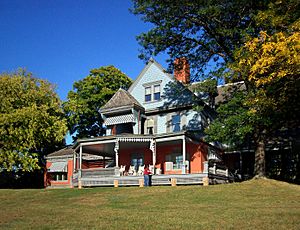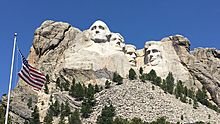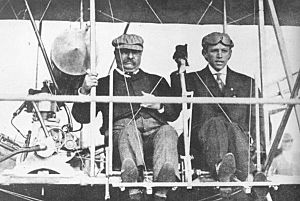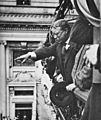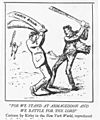Theodore Roosevelt facts for kids
Quick facts for kids
Theodore Roosevelt
|
|
|---|---|
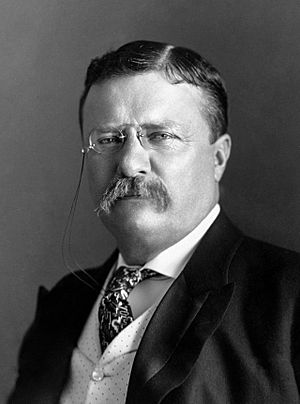
Portrait by the Pach Brothers, c. 1904
|
|
| 26th President of the United States | |
| In office September 14, 1901 – March 4, 1909 |
|
| Vice President |
|
| Preceded by | William McKinley |
| Succeeded by | William Howard Taft |
| 25th Vice President of the United States | |
| In office March 4, 1901 – September 14, 1901 |
|
| President | William McKinley |
| Preceded by | Garret Hobart |
| Succeeded by | Charles W. Fairbanks |
| 33rd Governor of New York | |
| In office January 1, 1899 – December 31, 1900 |
|
| Lieutenant | Timothy L. Woodruff |
| Preceded by | Frank S. Black |
| Succeeded by | Benjamin Barker Odell Jr. |
| 5th Assistant Secretary of the Navy | |
| In office April 19, 1897 – May 10, 1898 |
|
| President | William McKinley |
| Preceded by | William McAdoo |
| Succeeded by | Charles Herbert Allen |
| President of the New York City Board of Police Commissioners | |
| In office May 6, 1895 – April 19, 1897 |
|
| Appointed by | William Lafayette Strong |
| Preceded by | James J. Martin |
| Succeeded by | Frank Moss |
| Commissioner of the United States Civil Service Commission | |
| In office May 7, 1889 – May 6, 1895 |
|
| Appointed by | Benjamin Harrison |
| Preceded by | John H. Oberly |
| Succeeded by | John B. Harlow |
| Minority Leader of the New York State Assembly | |
| In office January 1, 1883 – December 31, 1883 |
|
| Preceded by | Thomas G. Alvord |
| Succeeded by | Frank Rice |
| Member of the New York State Assembly from the 21st district |
|
| In office January 1, 1882 – December 31, 1884 |
|
| Preceded by | William J. Trimble |
| Succeeded by | Henry A. Barnum |
| Personal details | |
| Born |
Theodore Roosevelt Jr.
October 27, 1858 New York City, New York, U.S. |
| Died | January 6, 1919 (aged 60) Oyster Bay, New York, U.S. |
| Resting place | Youngs Memorial Cemetery, Oyster Bay |
| Political party | Republican (1880–1912, 1916–1919) |
| Other political affiliations |
Progressive "Bull Moose" (1912–1916) |
| Spouses |
|
| Children |
|
| Parents |
|
| Relatives | Roosevelt family |
| Alma mater | Harvard University (AB) Columbia University |
| Occupation |
|
| Civilian awards | Nobel Peace Prize (1906) |
| Signature | |
| Military service | |
| Branch/service | United States Army |
| Years of service |
|
| Rank | Colonel |
| Commands | 1st U.S. Volunteer Cavalry |
| Battles/wars | |
| Military awards | Medal of Honor (posthumous, 2001) |
Theodore Roosevelt Jr. (born October 27, 1858 – died January 6, 1919) was an American politician, soldier, and writer. People often called him Teddy or T. R.. He became the 26th president of the United States, serving from 1901 to 1909. Before that, he was the 25th vice president under President William McKinley and the 33rd governor of New York.
Roosevelt became President after President McKinley was sadly killed. He quickly became a strong leader for the Republican Party. He pushed for new laws to control big businesses and supported ideas to make society better, known as Progressive policies.
Contents
- Early Life and Childhood
- Education and Learning
- Political Career and Public Service
- Death
- Personal Life and Family
- The Story of the Teddy Bear
- Character and Beliefs
- Interesting Facts About Theodore Roosevelt
- Legacy and Impact
- Famous Theodore Roosevelt Quotes
- Memorials and Cultural Depictions
- Audiovisual Media
- See also
- Images for kids
Early Life and Childhood
Theodore Roosevelt Jr. was born on October 27, 1858, in Manhattan, New York City. He was the second of four children. His mother was Martha Stewart Bulloch, and his father was Theodore Roosevelt Sr., a successful businessman.
As a child, Theodore was often sick with asthma. He had scary asthma attacks at night. Doctors at the time did not have a cure. Even so, he was very active and curious. His love for zoology (the study of animals) started when he was seven. He saw a dead seal at a market. He got the seal's head and, with his cousins, started the "Roosevelt Museum of Natural History." He learned how to prepare animals for display and filled his museum with creatures he found. When he was nine, he wrote a paper about insects.
Theodore's father was a big influence on him. His father was a leader in New York's cultural life. He helped start the Metropolitan Museum of Art. He also helped the Union during the American Civil War. Theodore said his father was "the best man I ever knew." He taught his children to be strong, brave, and kind.
The Roosevelt family traveled a lot. They visited Europe in 1869 and 1870, and Egypt in 1872. While hiking in the Alps in 1869, Theodore found that physical exercise helped his asthma. He started to exercise a lot. After being pushed around by older boys on a camping trip, he hired a boxing coach. He wanted to learn to fight and make his body stronger.
Education and Learning
Theodore was homeschooled by tutors and his parents. He was good at geography and history. He also did well in biology, French, and German. However, he found mathematics and classical languages difficult.
He started at Harvard College on September 27, 1876. His father told him to focus on his morals, then his health, and then his studies. His father died suddenly on February 9, 1878. This was very hard for Theodore, but he worked even harder. He did well in science, philosophy, and public speaking. He continued to struggle with Latin and Greek. He studied biology deeply and was already a skilled naturalist and a published bird expert.
While at Harvard, Theodore enjoyed rowing and boxing. He was even a runner-up in a boxing tournament. He was part of several clubs and was an editor for The Harvard Advocate newspaper.
In 1880, Theodore graduated from Harvard with high honors. He was among the top students in his class.
After his father's death, Theodore inherited $65,000. This was enough money for him to live comfortably. He decided not to study natural science anymore. Instead, he chose to go to Columbia Law School in New York City. Even though he was a good law student, he often found law confusing. He spent much of his time writing a book about the War of 1812. This book helped him become known as a smart historian and a popular writer.
Political Career and Public Service
After spending time in North Dakota, Theodore Roosevelt started his political career. He was elected to the New York State Legislature. He also served as a Civil Service Commissioner. Later, he became the New York City police commissioner. This job meant he was in charge of making the police department run smoothly.
In 1897, he became the Assistant Secretary of the Navy. But he left that job to fight in the Spanish–American War.
Roosevelt then became the Governor of New York. After that, he was elected Vice-President. When William McKinley was shot and killed, Theodore Roosevelt became the President of the United States.
Soldier and Rough Rider
Roosevelt joined the U.S. Army during the Spanish–American War. He was a Lieutenant Colonel in the 1st U.S. Volunteer Cavalry. These horsemen were famously known as the "Rough Riders."
He showed great bravery during the war. For his actions, he was recommended for the Medal of Honor.
In 2001, Theodore Roosevelt became the first President to receive the Medal of Honor. It was given to him after his death.
Presidency: A "Big Stick" and a "Square Deal"
As President, Roosevelt worked to make the U.S. a world power. This meant making it one of the most powerful countries. His foreign policy was like an African proverb: "Speak softly and carry a big stick." This meant he would try to talk things out peacefully, but he was ready to use military strength if needed. He made the United States' navy much larger. He sent the ships around the world to show other countries that the U.S. was now a strong global power.
He continued the Monroe Doctrine, which meant the U.S. would protect countries in Latin America. He used the country's military to influence politics in Latin America. He also had the Panama Canal built. This canal allowed ships to travel much faster by taking a shortcut between the Atlantic and Pacific oceans. As president, he cared about what happened in other countries. In 1905, he helped end the war between the Russian and Japanese empires. He won a Nobel Peace Prize for this in 1906.
At home, he wanted all Americans to have a "Square Deal." This meant everyone should have an equal chance to succeed. As part of his Square Deal, he:
- Controlled large businesses called trusts.
- Supported laws to help working people.
- Required meat and drugs to be inspected for safety.
- Protected the environment.
These ideas later inspired other presidents to expand the government's role in the economy.
Life After the Presidency
Roosevelt chose not to run for President in 1908. He wanted William Howard Taft to be the next President. Taft won the election. After leaving office, Roosevelt went to Africa to hunt big game. However, when he came back, he felt Taft was not doing a good job. He decided to run against Taft for President in 1912. During his campaign, he was shot but survived. Both Roosevelt and Taft lost to Woodrow Wilson. Roosevelt also thought Wilson was not doing a good job. He wanted the U.S. to join World War I years before they did.
Death
On the night of January 5, 1919, Roosevelt had trouble breathing. After getting help from his doctor, he felt better and went to bed. His last words were "Please put out that light, James" to his servant. Between 4:00 and 4:15 the next morning, Roosevelt died in his sleep at Sagamore Hill. He was 60 years old. He died because a blood clot traveled to his lungs.
When his son Archibald heard the news, he sent a telegram to his siblings saying, "The old lion is dead." Woodrow Wilson's vice president, Thomas R. Marshall, said that "Death had to take Roosevelt sleeping, for if he had been awake, there would have been a fight."
A private service was held at Sagamore Hill. A simple funeral followed at Christ Episcopal Church in Oyster Bay. Many important people attended, including Vice President Thomas R. Marshall and William Howard Taft. The path to Youngs Memorial Cemetery was covered in snow. People lined the route, and police officers rode from New York City. Roosevelt was buried on a hillside overlooking Oyster Bay.
Personal Life and Family
In 1880, Theodore Roosevelt married Alice Hathaway Lee. Their daughter, Alice Lee Roosevelt, was born on February 12, 1884. Sadly, two days later, Alice Hathaway Lee died from kidney failure. His mother, Martha, had died just eleven hours earlier in the same house. Theodore was heartbroken. He left baby Alice with his sister while he grieved. He took care of Alice when she was three years old.
After the deaths of his wife and mother, Roosevelt focused on his work. For the rest of his life, he rarely spoke about his first wife, Alice. He did not write about her in his autobiography.
On December 2, 1886, Roosevelt married his childhood friend, Edith Kermit Carow. Theodore felt worried that he was marrying so soon after his first wife's death. His sisters also had some concerns. However, the couple married in London, England.
The couple had five children:
- Theodore "Ted" III (born 1887)
- Kermit (born 1889)
- Ethel (born 1891)
- Archibald (born 1894)
- Quentin (born 1897)
They also raised Roosevelt's daughter from his first marriage, Alice. Alice often had disagreements with her stepmother.
The Story of the Teddy Bear
The famous teddy bear was named after Theodore Roosevelt.
In 1902, Roosevelt went on a bear-hunting trip in Mississippi. During the trip, he refused to kill a bear that had been captured. He said it was "unsportsmanlike" to shoot a trapped animal. News of this hunting trip spread. Many newspapers printed cartoons showing "Teddy" and "the bear."
A shop owner named Morris Michtom saw one of these cartoons. He had an idea. Michtom and his wife made soft, stuffed bears. They put them in their shop window. With permission from Roosevelt, Michtom named the bears "Teddy bears." They became very popular right away, and the name has been used ever since.
Character and Beliefs
Roosevelt always believed in living what he called "The Strenuous Life." He exercised regularly. He enjoyed boxing, tennis, hiking, rowing, polo, and horseback riding. He even continued to swim naked in the Potomac River during the winter. As governor of New York, he boxed with partners several times a week. He continued this as president until he was hit so hard that he lost sight in his left eye. This fact was not made public until many years later.
As president, he also practiced judo for two periods in 1902 and 1904. He believed that jiu-jitsu training was useful. He worried that the U.S. might fall behind other strong countries like Japan. So, he started to suggest that American soldiers should learn jiu-jitsu.
Roosevelt was also a big fan of singlestick (a type of sword fighting). In 1905, he even showed up at a White House party with his arm bandaged after a fight with General Leonard Wood.
Interesting Facts About Theodore Roosevelt
- Roosevelt was a sickly child with asthma. He became healthy by living a very active life.
- His family came from many different places, including Dutch, Scottish, English, German, Welsh, and French backgrounds.
- Theodore's fourth cousin, James Roosevelt I, was the father of President Franklin Delano Roosevelt.
- When he was 6 years old, Roosevelt watched the funeral procession of Abraham Lincoln from his grandfather's house in New York City.
- Roosevelt had an amazing memory, almost like a photograph.
- His first wife and mother died on the same night. This was a very difficult time for him.
- Roosevelt became president at age 42. He is still the youngest person ever to become president of the United States.
- He helped end the Russo-Japanese War. For this, he won the 1906 Nobel Peace Prize. He was the first American to ever win a Nobel Prize.
- On October 14, 1912, Roosevelt was shot in the chest by a man named John Flammang Schrank. He survived because the bullet got stuck in his chest muscle. Doctors decided it was safer to leave the bullet in. Roosevelt carried it for the rest of his life.
- When asked if the shooting would affect his election campaign, he famously said, "I'm fit as a bull moose." The bull moose became a symbol for Roosevelt and his Progressive Party.
- Roosevelt was a very active writer. He wrote about 18 books, including his autobiography, The Rough Riders, and History of the Naval War of 1812. He also wrote about ranching, explorations, and wildlife.
- He owned a large ranch in North Dakota. He also hunted large animals around the world and was involved with the Boy Scouts of America.
- Roosevelt loved to read. He read tens of thousands of books, sometimes several a day, in many languages. Along with Thomas Jefferson, he was one of the most well-read American presidents.
- Roosevelt did not like being called "Teddy," even though many people used the nickname.
- He went to church regularly and was a lifelong member of the Reformed Church in America.
- He was an active Freemason and a member of the Sons of the American Revolution.
- In 1913-1914, Roosevelt led a four-month trip to the Amazon basin. He almost died from a tropical disease there.
- Historians and political scientists often rank him as one of the greatest presidents in American history.
Legacy and Impact
Roosevelt is remembered as a pioneering conservationist. During his time as president, he protected 240 million acres of public land. This land became national parks, forests, monuments, and wildlife refuges.
He was also a progressive social reformer. He used the power of the White House to support laws for welfare, government regulation, and conservation. He believed in making society fairer for everyone, with economic opportunities for all Americans.
Roosevelt also changed foreign affairs. He believed the United States had a global responsibility. He thought a strong foreign policy helped American interests. He was key in building the Panama Canal. He also won the Nobel Peace Prize for helping to end the Russo-Japanese War.
While Roosevelt made many important contributions, some of his views are now seen as outdated or wrong. For example, he held some views that are now considered racist. However, he is still remembered as a person who greatly impacted American society and politics.
Roosevelt's ideas about protecting natural resources for future generations are still very important today.
Famous Theodore Roosevelt Quotes
- “It is hard to fail, but it is worse never to have tried to succeed.”
- “Believe you can and you're halfway there.”
- “People don't care how much you know until they know how much you care.”
- “When you're at the end of your rope, tie a knot and hold on.”
- “The only man who never makes mistakes is the man who never does anything.”
- “Knowing what's right doesn't mean much unless you do what's right.”
- “Keep your eyes on the stars, and your feet on the ground.”
- “Courage is not having the strength to go on; it is going on when you don't have the strength.”
- “I am a part of everything that I have read.”
Memorials and Cultural Depictions
Theodore Roosevelt is carved into the Mount Rushmore Memorial. He is there with Presidents George Washington, Thomas Jefferson, and Abraham Lincoln. The memorial was designed in 1927.
For his bravery at San Juan Hill, Roosevelt was recommended for the Medal of Honor. On January 16, 2001, President Bill Clinton gave Theodore Roosevelt the Medal of Honor after his death. He is the only president to have received this award.
The United States Navy named two ships after Roosevelt:
- The USS Theodore Roosevelt (SSBN-600), a submarine (1961–1982).
- The USS Theodore Roosevelt (CVN-71), an aircraft carrier (active since 1986).
The United States Postal Service has released postage stamps honoring Roosevelt. A 6¢ stamp was issued in 1956, and a 32¢ stamp in 1998. In 2008, Columbia Law School gave Roosevelt a law degree after his death.
Roosevelt's famous saying, "Speak Softly and Carry a Big Stick," is still used by politicians today. Another lasting legacy is the stuffed toy bears, teddy bears, named after him. This happened after the hunting trip incident in Mississippi in 1902.
Roosevelt has been shown in many films and TV shows. Robin Williams played him as a wax mannequin that comes to life in the Night at the Museum movies. Leonardo DiCaprio is set to play Roosevelt in a future movie. Roosevelt also appears as a leader in the video game Civilization VI.
Theodore Roosevelt National Park in North Dakota is named after him. The America the Beautiful Quarters series features Roosevelt riding a horse on the national park's quarter.
An asteroid, 188693 Roosevelt, was named after him in 2019. Explorers Robert Peary named the Roosevelt Range and Roosevelt Land after him.
For 80 years, a statue of Theodore Roosevelt stood in front of New York's American Museum of Natural History. The statue showed him on a horse, with a Native American and an African American walking beside him. In January 2022, the statue was removed. The museum said the statue's "hierarchical composition" (meaning how it showed people in different levels of importance) was the reason.
Audiovisual Media
- Theodore Roosevelt was one of the first presidents whose voice was recorded. Several of his speeches still exist. A 4.6-minute recording from 1912, called The Right of the People to Rule, can be heard. In it, he defends the Progressive Party.
- Roosevelt goes for a ride in Arch Hoxsey's plane in October 1910.
See also
 In Spanish: Theodore Roosevelt para niños
In Spanish: Theodore Roosevelt para niños
- Electoral history of Theodore Roosevelt
- First inauguration of Theodore Roosevelt
- List of famous big game hunters
- Second inauguration of Theodore Roosevelt
- Theodore Roosevelt Digital Library
- Presidents of the United States on U.S. postage stamps
- Teddy bear
- SS President Roosevelt (1921)
- SS President Roosevelt (1944)
- SS Roosevelt (1905)
Images for kids
-
Theodore Roosevelt as Badlands hunter in 1885. New York studio photo.
-
The Asiatic Squadron destroying the Spanish fleet in the Battle of Manila Bay on May 1, 1898
-
Colonel Roosevelt and the Rough Riders after capturing Kettle Hill in Cuba in July 1898, along with members of the 3rd Volunteers and the regular Army black 10th Cavalry
-
Official White House Portrait by John Singer Sargent
-
Roosevelt driving through a sequoia tree tunnel
-
The U.S.'s intentions to influence the area (especially the Panama Canal construction and control) led to the separation of Panama from Colombia in 1903.
-
1903 cartoon: "Go Away, Little Man, and Don't Bother Me". Roosevelt intimidating Colombia to acquire the Panama Canal Zone.


